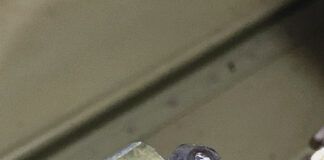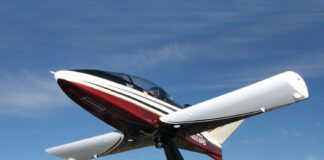The prospective buyer sent out Tyler Henshaw to inspect the AirCam before purchase and delivery. Henshaw knew something about Rotax engines (a plus), flies jets (a source of envy), races sailboats, and does all kinds of other useful things. He started inspecting, and I figured he’d find something I didn’t know about, I’d be embarrassed, and I’d have to spend a few hours tidying up this and that. After all, every inspector new to an airplane always finds something.
What with the Iowa winter and such, the engines hadn’t been run in a while, so we wheeled the AirCam out of the hangar and started it up. Winds were 10G15, and even between the hangars, the AirCam responded to the call of the winds. At one point, there seemed to be an obvious vibration, enough to make me wonder what was going on, but changing rpm made it go away. Then again, the plane had never vibrated like that. Maybe it was the wind going through the prop disks at a funny angle. But I’d never felt that kind of thing before. Must be my imagination.
 After the runup, we pushed the AirCam back into the hangar for compression checks, using an automotive compression tester instead of the aircraft differential tester. Before the runup, there was a noticeable difference in the amount of compression for each cylinder, but that was for engines that hadn’t run since the start of an exceptionally chilly and long Iowa winter. The compression checks were fine, but then Henshaw started examining the props. The first photo shows what he saw.
After the runup, we pushed the AirCam back into the hangar for compression checks, using an automotive compression tester instead of the aircraft differential tester. Before the runup, there was a noticeable difference in the amount of compression for each cylinder, but that was for engines that hadn’t run since the start of an exceptionally chilly and long Iowa winter. The compression checks were fine, but then Henshaw started examining the props. The first photo shows what he saw.Well, that wasn’t good. Suppose that puppy had let loose in flight? It would have vibrated like mad, possibly with separation of the engine or a slung propeller blade going through something structurally significant or through a control cable. Not good! I probably would have yanked both throttles back, and if that hadn’t been enough, I probably would have shut down both engines.
The preflight assumption? This is a twin-engine airplane, so it’s relatively safe to fly at low altitudes because it would be easy to handle an engine failure. That’s true enough, but a propeller failure is different from an engine failure. Loss of one propeller could cause extreme structural damage, or it could cause the pilot to do something that made sense at the moment but, in hindsight, might not have been a good choice–like shutting both engines down because it was too hard to tell which one was having problems, or because the vibration was so bad that it was making basic airmanship difficult and decision making impossible.
 After taking the propeller apart, we saw that the crack went nearly halfway around the prop. Looked like the angels were looking out for me.
After taking the propeller apart, we saw that the crack went nearly halfway around the prop. Looked like the angels were looking out for me.So the next step was to take things apart, replace speculation with fact, and get on with flying. Turns out that Warp Drive, the manufacturer, is in Ventura. No, not that Ventura, but Ventura, Iowa, right next to Clear Lake, Iowa, whence Buddy Holly, the Big Bopper, and Ritchie Valens took off for South Dakota in a chartered Bonanza that fateful night. And it’s only a few hours’ drive from my current home in Iowa, so off I went.

Turns out that my fears of the prop coming apart were completely unfounded, as office manager Daryl Heinemann explained. The aluminum part is just a collar so that the aluminum hub has something to clamp onto other than bare carbon fiber. In fact, the entire prop is filled with carbon fiber from the hub to the tip, so no way it’s going to come apart. Before the resin is added and the entire prop is molded, it looks like a big old pony tail.
And those props are really, really light—a three-blade prop is an easy one-hand lift. But here’s another irony—lighter isn’t necessarily better. Ever look at a flywheel and see that most of the weight is near the rim? This gives the flywheel more rotational inertia and less weight. So if the blades are super light, you need even more weight to be in the flywheel for the same rotational inertia.
So what happened to my prop to cause it to crack? Probably an engine kickback or something like that on starting, because there was no prop strike. In fact, the kind of crack that the one blade showed is common. Nevertheless, Heinemann recommended replacing the blade. I also traded in my hubs for a new design that looked better and got new bolts all around. Now all that’s left to do is to put them on the AirCam and go fly. However, Warp Drive recommends re-torquing the bolts every 5 flight hours, so I’ll need a torque wrench that can live in the hangar and go on trips.

By the way… one of the prop blades on display was from a gyro, and it had eaten a seat belt buckle in flight. Loose objects going through the prop are always a concern on pusher installations, but after seeing this blade, I don’t think I have to worry about losing a Warp Drive prop if something goes through it in flight. But I’ll still be glad I rethought the safety procedures.




